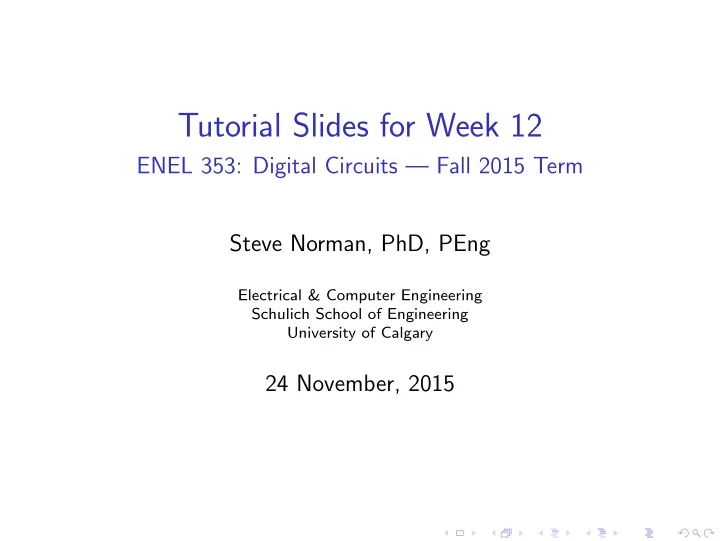

Tutorial Slides for Week 12 ENEL 353: Digital Circuits — Fall 2015 Term Steve Norman, PhD, PEng Electrical & Computer Engineering Schulich School of Engineering University of Calgary 24 November, 2015
slide 2/9 ENEL 353 F15 Tutorial Slides for Week 12 Topics for today An FSM design problem. An FSM analysis problem. Problems about timing of synchronous sequential logic.
slide 3/9 ENEL 353 F15 Tutorial Slides for Week 12 Exercise 1: Mealy FSM design Here’s a specification for an FSM: ◮ inputs are CLK, reset, and a 1-bit signal called A; ◮ output is a 1-bit signal called Y; ◮ on reset, Y should go to 0 as quickly as possible; ◮ Y should be 1 if the current value of A matches the value of A at the last two rising edges of CLK. Why does this require a Mealy FSM? (Why can’t it be Moore?) Let’s draw a state transition diagram. Let’s make a combined state transition and output table, using symbols (S0, S1, etc.) to represent the states.
slide 4/9 ENEL 353 F15 Tutorial Slides for Week 12 For convenience, here’s a repeat of the specification: ◮ inputs are CLK, reset, and a 1-bit signal called A; ◮ output is a 1-bit signal called Y; ◮ on reset, Y should go to 0 as quickly as possible; ◮ Y should be 1 if the current value of A matches the value of A at the last two rising edges of CLK. We won’t continue all the way to next-state equations and a schematic, but let’s think about some of the steps. What is the minimum number of state bits? If we choose a state encoding with that number of bits, how many rows will the truth table for next-state and output logic have? Should the state register have synchronous or asynchronous reset?
slide 5/9 ENEL 353 F15 Tutorial Slides for Week 12 Exercise 2: Analysis of an FSM CLK S 1 A S 0 Y r reset Is this a Moore FSM or a Mealy FSM? Let’s draw a state transition diagram for the circuit.
slide 6/9 ENEL 353 F15 Tutorial Slides for Week 12 Exercise 3: FSM analysis, continued Describe in English what the circuit of Exercise 2 does. Add a timing diagram if that helps with the description. (This is too fuzzy a question to put on a quiz or exam, but it’s useful to think about.)
slide 7/9 ENEL 353 F15 Tutorial Slides for Week 12 Exercise 4: Derivation of timing constraints CLK D1 Q1 D2 Q2 C L R1 R2 The math for this is very easy. The hard part is remembering what the problem specifications are! If you practice the derivations a few times, it may help you remember. Let’s assume that the input to R1 is well-behaved, that R1 and R2 have the same values for timing parameters, and that there is no clock skew. Let’s derive inequalities that, when true, guarantee that setup-and-hold-time violations cannot happen at the input to R2.
slide 8/9 ENEL 353 F15 Tutorial Slides for Week 12 Exercise 5: Application of timing constraints CLK Quux Y Foo Bar Zork Z R1 R2 Foo, Bar, Quux, and Zork are all combinational logic with these values for t pd , in ps: 250 for Foo, 60 for Bar, 100 for Quux, and 180 for Zork. For both R1 and R2, t setup = 75 ps and t pcq = 33 ps. What is the minimum clock period for safe operation of the circuit? (Assume that there is no clock skew.)
slide 9/9 ENEL 353 F15 Tutorial Slides for Week 12 The last two tutorial periods Tue Dec 1: Quiz #5. ◮ Topics will definitely include FSM design and analysis, and timing of synchronous circuits with and without clock skew. ◮ It’s possible that there may also be a simple problem on memory arrays, depending on what is covered in lecture Mon Nov 30. Tue Dec 8. Exercises related to memory arrays, and probably also a few final exam review exercises.
Recommend
More recommend